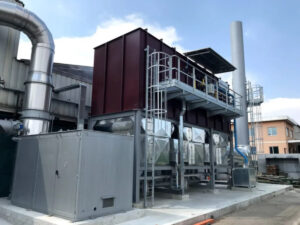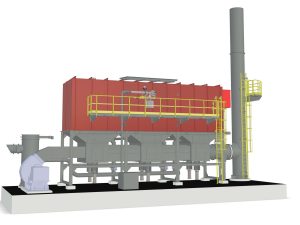- Zinc Recovery and Metallurgy: Effective Solutions for Carbon Monoxide Emissions
- Carbon monoxide emissions: Zinc recovery in metallurgy
- Zinc recovery plant: environmental impact
- Purification targets
- The high-performance technical solution for monoxide (CO) abatement: 5-chamber regenerative thermal oxidation
- Dedicated plant solutions for the metal industry
- Carbon monoxide abatement with RTO: the results
- Go to the gallery with all our systems
Reducing Carbon Monoxide (CO) in the foundry and metallurgy sector
Regenerative thermal oxidation is a viable solution for the reduction of air pollutants such as carbon monoxide (CO), which, given their hazardous nature, must be treated to ensure environmental safety.
Zinc Recovery and Metallurgy: Effective Solutions for Carbon Monoxide Emissions
In this case study we describe a technical solution that BrofindⓇ has applied at a major European company active in the recovery and reuse of zinc, a noble raw material found in various production wastes in the metals industry.
In particular, this recovery opportunity is related to steel production processes, which generate high amounts of waste material, better known by the English acronym EAFD (Electric Arc Furnace Dust), a waste classified as hazardous.
Within EAFD dust, the presence of zinc is particularly high, which, given the rising cost of waste disposal, is a motivating factor for the introduction of reuse solutions.
Nevertheless, the industrial process of separating, cleaning, and recovering zinc from raw waste material (EAFD) produces large amounts of carbon monoxide (CO).
Carbon monoxide emissions: Zinc recovery in metallurgy
Air emissions from zinc recovery processes using waelz furnaces possess the following characteristics:
| VARIABLE | FEATURES |
|---|---|
| Temperature | 130 – 150 °C (downstream dedusting processes) |
| Emission composition | O2 11,08 % vol. CO 1,2 – 3 % vol. (15-37 g/Nm³) CO2 8,58 % vol. H2O 7,70 % vol. N2 70,56 % vol. |
| Flow rates of emitted air | 70.000 Nm 3 /h |
| Operating cycle | On multiple daily shifts |
| Variability | Limited |
Zinc recovery plant: environmental impact
The element to be recovered, zinc, can be present within production waste in the form of different compounds, such as:
- zinc oxide
- zinc silicate
- zinc ferrite
- zinc sulfide
- other
The recovery process involves treating production waste with a carbon-containing reducing agent/fuel inside a rotary furnace at temperatures between 1000 °C and 1500 °C.
This triggers a chemical process known as the WAELZ process, which involves the reduction of zinc compounds to elemental zinc, which, having a boiling point of 907 °C, changes state and oxidizes in the gas phase to zinc oxide. The zinc oxide is then collected at the outlet of the furnace by bag filters, which, being mechanical filters, are useful for dedusting but are unable to break down the excess carbon monoxide generated in the oxidation process.
Therefore, without an additional abatement process, a high amount of CO, which is an extremely poisonous gas, would be released into the atmosphere; suffice it to say that an adult human finds death within 30 minutes in an environment containing 0.1 percent CO.
Purification targets
The purification goal is to reduce the emission of Carbon Monoxide (CO) into the atmosphere as much as possible, allowing compliance with the regulatory limits set for the specific pollutants present.
The high-performance technical solution for monoxide (CO) abatement: 5-chamber regenerative thermal oxidation
Considering the fact that during analysis the data clearly indicated emissions with nearly constant air flow characteristics and also considerable pollutant mass flows, a 5-chamber regenerative thermal oxidation plant was installed.
In this solution, each regenerative chamber contains a ceramic bed that functions as a heat accumulator and is heated-or cooled-depending on the direction of the emission flow through it.
The emission to be purified reaches chambers 1 and 2 and passes through the ceramic bed that has been heated, during the previous step, so it is heated to a temperature as close as possible to the reaction temperature (which is about 900 °C).
This temperature is maintained by self-combustion of the contaminants in the emission, but it can also be controlled by the introduction of auxiliary fuel into the heating transistors. The emission to be treated remains at the combustion temperature for a sufficient residence time.
After leaving the combustion chamber, the purified emission flows vertically from top to bottom through chambers 3 and 4. The average duration of these intervals is variable and is automatically adjusted according to a logical process that is part of Brofind’s know-how.
The fifth chamber allows for further treatment of the part of the emission that is not fully treated, which, during flow reversal, could, without it, be conveyed directly to the stack.
Dedicated plant solutions for the metal industry
The specific application, carried out by a leader in the Zinc metallurgical industry, has, necessarily, involved the identification and application of customized plant solutions designed to enable the following goals to be achieved:
- Optimization of operational and energy cost
- minimization of additional auxiliary fuel consumption, achieved by regenerative preheating of exhaust air to a temperature close to the reaction temperature.
- choice of ceramic materials that can ensure minimal energy consumption due to their high compressive strength and
- high thermal inertia
- recovery of excess heat energy where the stack effluent has a good temperature and thus allows indirect heat recovery by installing an exchanger to heat, for example, combustion air for burners, or to use air for driers or desiccators.
- Safety and operation
-
- Design aimed at limiting the risks of clogging due to the presence of dust
- Plant layout made to facilitate maintenance operations
- Performance and compliance
-
- Technical solution with 5-chamber regenerative oxidizer, guaranteeing a high degree of air purification
- Process management aimed at extremely low generation of secondary contaminants ( TOC ⥶ 20 mg C/Nm3 , CO ⥶ 50 mg/Nm3, NOx ⥶ 50 mg/Nm3)
Carbon monoxide abatement with RTO: the results
The application of the described technology, customized for a better fit with the technical requirements of the job order, enabled the full achievement of all targets. In particular:
- Achievement of output Carbon Monoxide concentration values well below the prescribed regulatory limits
- Minimization of energy consumption due to high-efficiency energy recovery,
- No interference with thermal and fluid-dynamic conditions in the rotary furnace upstream of the purification plant
- Easy safe access for internal inspection and scheduled maintenance operations

